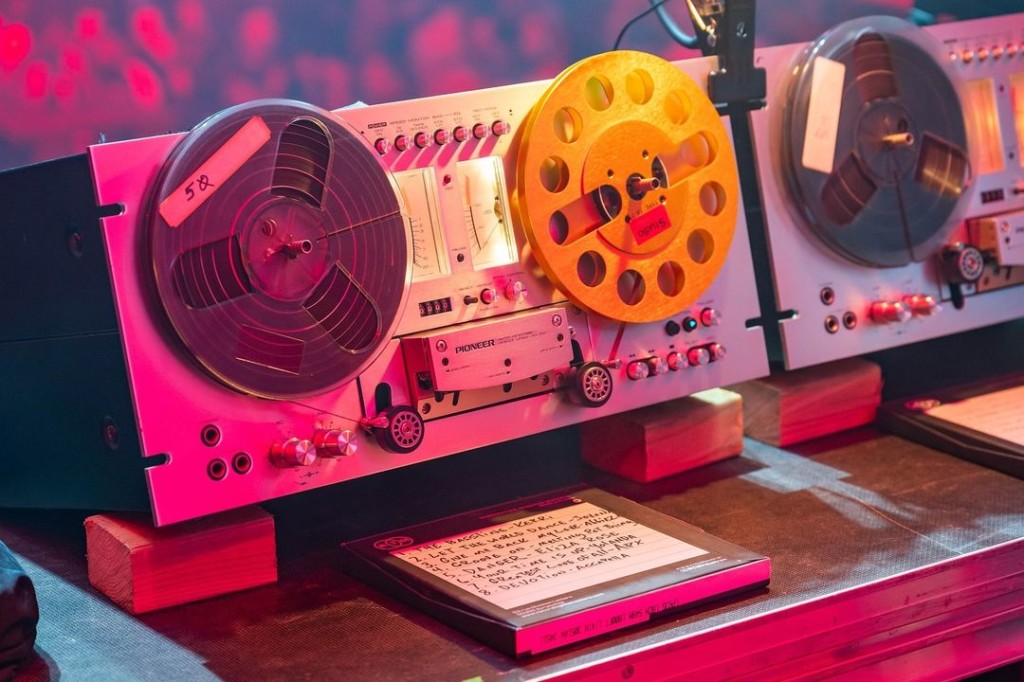Everybody’s a DJ until you put four tape machines in front of them. Yeah, to vinyl purists, Kerri Chandler continues to tour his all tape DJ rig, and it never gets old.
This month, Kerri Chandler’s tapes closed out SONAR in Barcelona, a beautiful, tactile end to three days of music in Catalunya. (That venue SONAR claims is the “largest dancefloor in the world.” It’s a cavernous continuous convention floor environment that comfortably accommodates crowds of 15,000 in a way that makes that number feel like an intimate club.)
RA’s studio recording of Kerri’s setup is the best way to watch this because you can see how he works.
This isn’t just a random novelty: it’s a legend reproducing equipment from back in the day. And technologically speaking, you could make a decent argument that the reel-to-reel is better than vinyl, as Kerri explained to RA in the feature accompanying the story:
“Unlike turntables, you don’t have to worry about skipping, vibrations or a dirty stylus. In fact at times if I saw the needle was a bit dirty while I was playing out at a club, I would make a quick copy to tape for about a minute, run it back, play the tape, clean the stylus and bring the record back in.”
Before easy access to digital recording tech, edits also meant splicing tape, meaning that a collection of historical edits could be found on tape as its natural habitat. More often, you’d see one tape machine for loops or as a backup to the turntables, but RA recalls that Frankie Knuckles and David Morales mixed on them.
The incredible thing is just how silky-smooth Kerri’s mixes are on this. Apart from the added labor of spooling the tape, it’s simply not as easy to cue and mix on tape as on vinyl – so why does this mix sound so much better than a lot of digital mixing?
And the gear is gorgeous.
You’ll see a ton of planning in these sets, too – check the handwritten notes and tape prep.

The tape machine in question here is a Pioneer RT-707, produced in Japan from 1977-1982.That has the advantage of being slightly more compact – well, as reel-to-reels go. It has the rack-mount design with the reels in front instead of towering above the device like Mickey Mouse ears as on many other devices of the era. (That looks more comfortable in the DJ booth to me, anyway.)
And there is a pitch control on the front, albeit with a small potentiometer for control.
Reel to Reel writes about it – there’s auto-reverse and high-end sound without being quite as expensive as some of the devices in its class:
The Pioneer RT-707 is a rack-mountable stereo four-track tape deck with three motors and a pitch controllable AC Servo Direct Drive capstan motor. No belts to stretch or crack, ensuring low wow & flutter over a long working life. This machine is built like a tank and most technicians will tell you that they don’t see many of these in for service. With its unique dimensions, it is similar to the RT-701 which was introduced one year earlier. The 707 added foil-sensing auto reverse for playback and the following additions located on the back panel- output level pots , DIN input outputs and switched AC terminals. Recording can only be done in the forward direction only.
Of course, reel-to-reel enthusiasts will likely have their favorite device from Otari, TEAC/Tascam, etc.
I have fond memories of my dad’s TEAC player and the household collection of reels that sat between the vinyl and, eventually, compact cassette. Reel-to-reel equipment has become a problematic format, though, because of cost of the medium itself – the gear is actually not so difficult to find and maintain. Basically, it would help if you had Kerri Chandler’s fees. But we can enjoy the results for free.
Here, have some more music. It’s almost better than air conditioning for the summer.
On a budget?
I recommend compact cassettes: cheaper machines, cheaper media (by far), and easier to travel with! Have I written about something like that before? Yes, yes I have: